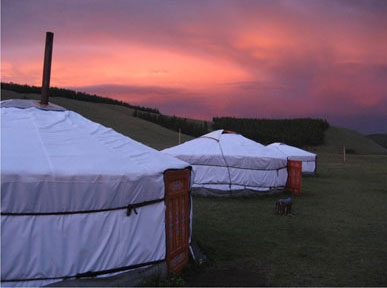A boggy dirt path is the only road to the nearest town. To accommodate rapidly shifting temperatures that might see a warm day in June turn into a couple of days of heavy snowfall, large circular tents, or gers, are draped with layers of felt. Yaks, sheep and cashmere goats graze amongst a diversity of plants that includes fresh thyme. This is northern Mongolia. This is home to the Penn Department of Biology's climate change field study.
The program, headed by professors Peter Petraitis and Brenda Casper, is a collaboration between the Department, the Academy of Natural Sciences of Philadelphia, the National University of Mongolia, the Mongolian University of Science and Technology and the Mongolian Academy of Sciences. Funding is provided by the National Science Foundation's Partnerships for International Research and Education (PIRE) grant. The region was chosen because it is expected to experience some of the largest temperature increases worldwide, mainly due to its location at 50°N latitude, its 5,000 foot elevation—comparable to that of Denver—and its distance from the moderating influence of a large body of water.
"There was a call for proposals from the National Science Foundation for these PIRE grants. At that point I was the only member of the faculty in our department who had been to Mongolia," says lead primary investigator Petraitis. "The grant specified an international partnership, so I reached out to former Penn Ph.D. student and resident of Mongolia Bazartseren Boldgiv, a Professor of Ecology and Environmental Science at the National University of Mongolia. It evolved from there."
The research team, which includes numerous graduate and undergraduate students from Penn, as well as scholars from Mongolian universities, uses open-top and open-sided warming chambers to essentially hit the fast-forward button on global warming. The devices, plastic hexagonal domes with a base of one-and-a-half meters, mimic future temperatures so that various ecological scenarios can be observed within.
The field site is located in a valley on the outskirts of Lake Hövsgöl and plays host to two important ecosystems: the semi-arid steppe grassland, where the majority of the team's research is conducted, and the taiga forest. In order to understand the impact of climate change on the ecology of the region, the team must account for variables like grazing and precipitation. Also central to the research is charting changes to plant community composition. For this the team places grids on the ground in order to carefully document plant cover by species and growth.
"There's a lot of variation within the valley in terms of soil moisture, composition of vegetation and nitrogen input," says Casper. "We've duplicated the experiment at two different elevations, eliminating grazing in some locations and varying precipitation patterns using watering cans in others. All in all, there are four different experimental treatment comparisons and 75 total experimental plots."
The team is also interested in the broader activity of the ecological system. Anarmaa Sharkhuu, a graduate student in the Department of Earth and Environmental Science, is investigating carbon cycling, while others are analyzing stable isotopes in leaf tissues to determine whether nitrogen in the area has recently undergone fixation from atmospheric nitrogen. This transformation is only accomplished by certain organisms, notably legumes and lichens. Team members are also reconstructing past climate by analyzing the isotopic composition of tree rings.
"What we were surprised to find is that plants on the hill were receiving large amounts of fixed nitrogen, while plants in the valley were using nitrogen that had undergone more transformations by biological organisms. This suggests the primary site of input is up on the hill," Casper explains. "Prior to this discovery we had considered the heavy grazing on the hill to be detrimental, while in fact, grazing animals might remove competitors of nitrogen-fixing plants and redistribute nitrogen when relieving themselves down in the valley. So it turns out these animals might actually be necessary to the continued health of the system."
The migratory patterns of the herders, even the construction of their gers, might also have an effect on the system. Recent observations suggest that the placement of the tents affects the composition of the plant community the following year. For further analysis of the indigenous population's perception of climate change, locals are interviewed, resulting in anecdotal data about rain temperatures and grass growth and other variables important to the ecology of the area.
"One of the main opportunities in a study like this," says Petraitis, "is the chance to participate in these international collaborations and educate both Penn students and Mongolian students so that they may carry on the work we're doing. It's some of the hardest work we've done as practicing ecologists, but also some of the most rewarding."



